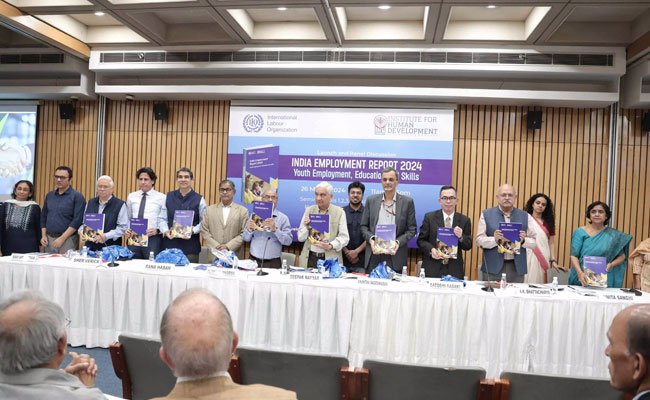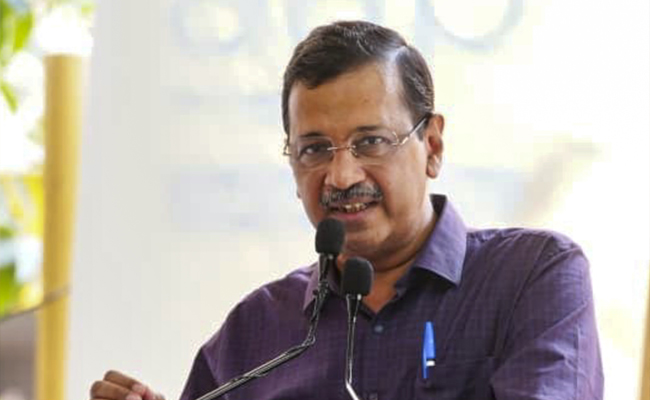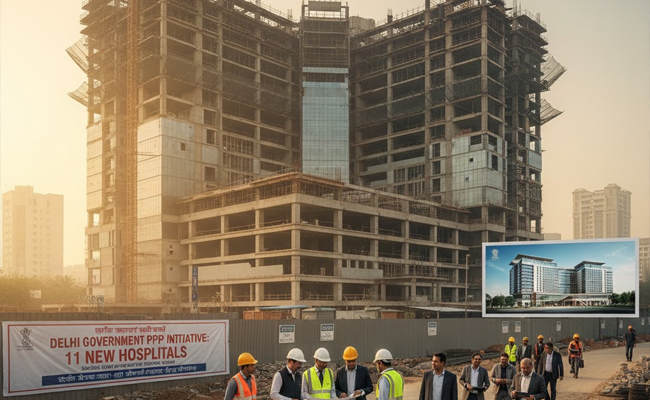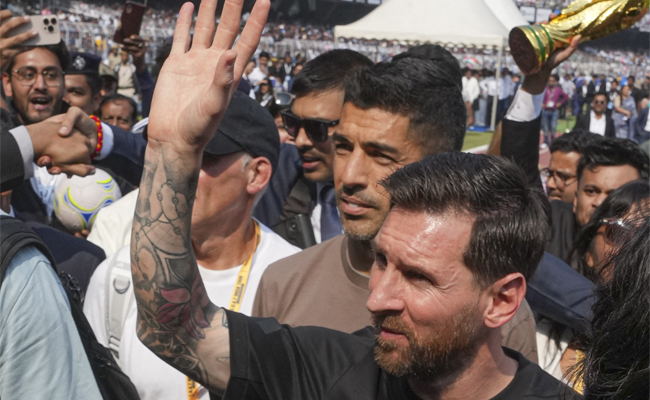New Delhi: The employment analysis of the Institute for Human Development (IHD) and International Labour Organisation (ILO), titled 'India Employment Report 2024' and released on Tuesday, has shown the employment condition in the country to be poor even after showing improvement in matters of overall labour force participation, workforce participation and employment rates in the past few years after battling a long-term downfall from 200 to 2019.
The report shows a reversal in the show transition to non-agricultural employment. It also throws light on facts like women contributing greatly for the hike in self-employment rate as well as unpaid family work, jobs available for youth being lower in quality than those for adults, unpaid family work also being higher in proportion for youths as compared to adults as well as stagnation or decline in wages and earnings.
Chief Economic Advisor V Anantha Nageswaran, who released the report, said that it would be incorrect to assume the need or demand government intervention for every social or economic problem as the industry was required to employ more people. "We need to get out of the mindset. In the normal world, it is the commercial sector, those who engage in for-profit activity, who need to do the hiring,” he said.
"The government has taken several actions to facilitate better employment opportunity, including skill development initiatives along with the National Education Policy (NEP), which is 'futuristic' and therefore, should not become hostage to political consideration," said Nageswaran.
The Chief Economic Advisor pointed out that several other facilities were provided by the government in the employment sector, like payment of employers' contribution to new employees under the Employees' Provident Fund Organisation (EPFO), Atmanirbhar Bharat Rozgar Yojana and the new tax regime that permits deduction of wages to employees, thereby "not favouring capital accumulation over employment generation".
Explaining that employment-seekers were provided opportunity to improve their skills, Nageswaran admitted that the availability of instructors and dropout rate were among the issues that need to be addressed by the government as there was scope for considerable improvement. He stated that the government was mindful of the issues too.
The report by IHD-ILO stated that the levels of youth employment and underemployment had increased in India from 2000 to 2019, but had fallen during the pandemic outbreak. It added that youths struggling to get jobs, especially those with at least a secondary level of education, had increased in number over the years, with 2022 recording the share of jobless youth among the total unemployed population in the country as 82.9 per cent. It said, "The share of educated youths among all unemployed people also increased, from 54.2 per cent in 2000 to 65.7 per cent in 2022. Among the educated (secondary level or higher) unemployed youths, women accounted for a larger share (76.7 per cent) than men (62.2 per cent). This indicates that the problem of unemployment in India has become increasingly concentrated among the youth, especially educated youths and women in urban areas."
It pointed out that economic policies were required to boost productive non-agriculture employment, especially in the manufacturing sector, as India is likely to add 7-8 million youth annually to the labour force over the next decade, approximately. India, therefore, needed to give priority to labour-intensive manufacturing works to absorb its abundant unskilled work force and to combine with select services, the report added.
The micro, small and medium enterprises need greater support, especially through a decentralized approach, including digitization and artificial intelligence as well as cluster-based approach to manufacturing. India needs to improve its quality of jobs by investing in and regulating the sectors like care and digital economy, which can be expected to contribute jobs for youths. With a hike expected in both urbanization and migration in India, the economy would need an inclusive urban policy to address the needs of migrants, women and impoverished youths, the analysis advised.
It further stated that skill development and active labour market policies (ALMPs) need more effective roles in bridging the gap between the supply and demand for jobs and also in making the overall labour market more inclusive. A larger and more targeted role for state governments, stronger partnerships with the private sector and other stakeholders and also greater contribution by the non-state and private sector would be needed to address the issue at hand, it added.
The IHD-ILO report highlighted five key policy areas to take further action on the matter - promoting job creation; improving employment quality; addressing labour market inequalities; strengthening skills and active labour market policies; and bridging the knowledge deficits on labour market patterns and youth employment.
Let the Truth be known. If you read VB and like VB, please be a VB Supporter and Help us deliver the Truth to one and all.
Panaji (PTI): As part of a crackdown against tourist establishments violating laws and safety norms in the aftermath of the Arpora fire tragedy, Goa authorities on Saturday sealed a renowned club at Vagator and revoked the fire department NOC of another club.
Cafe CO2 Goa, located on a cliff overlooking the Arabian Sea at Vagator beach in North Goa, was sealed. The move came two days after Goya Club, also in Vagator, was shut down for alleged violations of rules.
Elsewhere, campaigning for local body polls, AAP leader Arvind Kejriwal said the fire incident at Birch by Romeo Lane nightclub at Arpora, which claimed 25 lives on December 6, happened because the BJP government in the state was corrupt.
An inspection of Cafe CO2 Goa by a state government-appointed team revealed that the establishment, with a seating capacity of 250, did not possess a no-objection certificate (NOC) of the Fire and Emergency Services Department. The club, which sits atop Ozrant Cliff, also did not have structural stability, the team found.
The Fire and Emergency Services on Saturday also revoked the NOC issued to Diaz Pool Club and Bar at Anjuna as the fire extinguishers installed in the establishment were found to be inadequate, said divisional fire officer Shripad Gawas.
A notice was issued to Nitin Wadhwa, the partner of the club, he said in the order.
Campaigning at Chimbel village near Panaji in support of his party's Zilla Panchayat election candidate, Aam Aadmi Party leader Kejriwal said the nightclub fire at Arpora happened because of the "corruption of the Pramod Sawant-led state government."
"Why this fire incident happened? I read in the newspapers that the nightclub had no occupancy certificate, no building licence, no excise licence, no construction licence or trade licence. The entire club was illegal but still it was going on," he said.
"How could it go on? Couldn't Pramod Sawant or anyone else see it? I was told that hafta (bribe) was being paid," the former Delhi chief minister said.
A person can not work without bribing officials in the coastal state, Kejriwal said, alleging that officers, MLAs and even ministers are accepting bribes.





